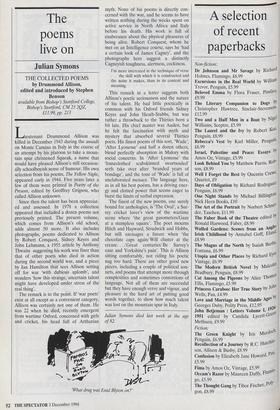The poems live on
Julian Symons
THE COLLECTED POEMS
by Drummond Allison, edited and introduced by Stephen Benson available from Bishop's Stortford College, Bishop's Stortford, CM 23 2QZ, £11.99, pp. 213 Lieutenant Drummond Allison was killed in December 1943 during the assault on Monte Camino in Italy in the course of an attempt by his platoon to take a moun- tain spur christened Squeak, a name that would have pleased Allison's still occasion- ally schoolboyish sense of humour. His own selection from his poems, The Yellow Night, appeared early in 1944. Five years later a few of them were printed in Poetry of the Present, edited by Geoffrey Grigson, who called Allison unknown.
Since then the talent has been appreciat- ed and assessed. In 1978 a collection appeared that included a dozen poems not previously printed. The present volume, which comes from Allison's old school, adds almost 50 more. It also includes photographs, poems dedicated to Allison by Robert Conquest, Sidney Keyes and John Lehmann, a 1955 article by Anthony Thwaite suggesting his work was finer than that of other poets who died in action during the second world war, and a piece by Ian Hamilton that sees Allison setting off for war 'with dubious aplomb', and wonders 'how this strange, uncertain talent might have developed under stress of the real thing'.
The remark is to the point. If 'war poets' exist at all except as a convenient category, Allison was certainly not one of them. He was 22 when he died, recently emergent from wartime Oxford, concerned with girls and cricket, his head full of Arthurian myth. None of his poems is directly con- cerned with the war, and he seems to have written nothing during the weeks spent on active service in North Africa and Italy before his death. His work is full of exuberance about the physical pleasures of being alive. Robert Conquest, whom he met on an Intelligence course, says he 'had a certain look of James Cagney', and the photographs here suggest a distinctly Cagneyish toughness, alertness, cockiness.
I'm more interested in the technique of verse . . . the skill with which it is constructed and the noise it makes, than in its content and meaning.
This remark in a letter suggests both Allison's poetic seriousness and the nature of his talent. He had little poetically in common with his Oxford friends Sidney Keyes and John Heath-Stubbs, but was rather a throwback to the Thirties born a bit late. His chief master was Auden, but he felt the fascination with myth and mystery that absorbed several Thirties poets. His finest poems of this sort, 'Wade', 'After Lyonesse' and half a dozen others, blend perfectly absorption in Malory with social concerns. In 'After Lyonesse' the `louseclothed scabskinned swartsouled' serfs take over after 'branded years of bondage', and the tone of 'Wade' is full of unelaborated menace. The language here, as in all his best poems, has a driving ener- gy and clotted power that seems eager to burst the limits of verbal expression.
The finest of the new poems, one surely bound for anthologies, is 'The Oval', a Sur- rey cricket lover's view of the wartime scene where 'the great gasometers/Gaze at a stumpless square'. The poet mourns Hitch and Hayward, Strudwick and Hobbs, but still envisages a future when 'the chocolate caps again/ Will cluster at the crease. . . /Great centuries/ Be Surrey's ease and Yorkshire's pain'. This is Allison sitting comfortably, not riding his poetic nag too hard. There are other good new pieces, including a couple of political son- nets, and poems that attempt more through complexities and sometimes contortions of language. Not all of them are successful but they have enough verve and vigour, and pleasure in the hard art of putting good words together, to show how much talent was lost on the mountain spur in Italy.
Julian Symons died last week at the age of 82.
'What drug was Enid Blytan on?'










































































 Previous page
Previous page